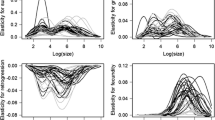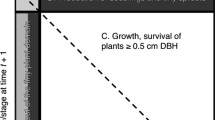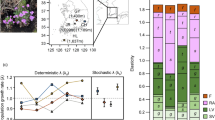Abstract
Plant populations may have evolved different demographic strategies to cope with temporal environmental variation. According to the demographic buffering hypothesis, vital rates that are most critical to population persistence are buffered against environmental variation and vary little over time, whereas the demographic lability hypothesis suggests that populations may track and benefit from environmental variation. While the hypotheses of demographic strategies have been widely tested in plant and animal species, they have not been explicitly examined for invasive plants, or in relation to different modelling methods (deterministic vs. stochastic). Here, we tested the demographic buffering and lability hypotheses for 23 populations of eight invasive plant species in relation to life form (woody vs. herbaceous species) and population growth rate using deterministic and stochastic modelling methods, and absolute and relative scales. We found that conclusions of demographic strategies depended on scale, with an absolute scale resulting in stronger negative correlations between the variability and importance of vital rates (i.e., buffering) than a relative scale. Conclusions of demographic strategies were also affected by life form that interacted with method. The populations of woody invaders exhibited buffering regardless of the method used, while for the populations of herbaceous species, deterministic calculations suggested buffering and stochastic calculations suggested lability. Overall, our findings emphasise the role of life form and methodological issues that need to be considered when exploring demographic strategies in fluctuating environments.


Similar content being viewed by others
References
Boyce MS, Haridas CV, Lee CT (2006) Demography in an increasingly variable world. Trends Ecol Evol 21:141–148
Burns JH, Blomberg SP, Crone EE, Ehrlen J, Knight TM, Pichancourt J-B, Ramula S, Wardle GM, Buckley YM (2010) Empirical tests of life-history evolution theory using phylogenetic analysis of plant demography. J Ecol 98:334–344
Caswell H (2001) Matrix population models, 2nd edn. Sinauer Associates, Sunderland
de Kroon H, van Groenendael J, Ehrlén J (2000) Elasticities: a review of methods and model limitations. Ecology 81:607–618
Development Core Team R (2013) R: a language and environment for statistical computing. R Foundation for Statistical Computing, Vienna
DeWalt SJ (2006) Population dynamics and potential for biological control of an exotic invasive shrub in Hawaiian rain forests. Biol Invasions 8:1145–1158
Franco M, Silvertown J (2004) Comparative demography of plants based upon elasticities of vital rates. Ecology 85:531–538
Gaillard JM, Yoccoz NG (2003) Temporal variation in survival of mammals: a case of environmental canalization? Ecology 84:3294–3306
Golubov J, Mandujano MD, Franco M, Montana C, Eguiarte LE, Lopez-Portillo J (1999) Demography of the invasive woody perennial Prosopis glandulosa (honey mesquite). J Ecol 87:955–962
Hansen MJ, Wilson SD (2006) Is management of an invasive grass Agropyron cristatum contingent on environmental variation? J Appl Ecol 43:269–280
Haridas CV, Tuljapurkar S (2005) Elasticities in variable environments: properties and implications. Am Nat 166:481–495
Higgins SI, Pickett STA, Bond WJ (2000) Predicting extinction risks for plants: environmental stochasticity can save declining populations. Trends Ecol Evol 15:516–520
Hüls J, Otte A, Eckstein RL (2007) Population life-cycle and stand structure in dense and open stands of the introduced tall herb Heracleum mantegazzianum. Biol Invasions 9:799–811
Jacquemyn H, Brys R, Neubert MG (2005) Fire increases invasive spread of Molinia caerulea mainly through changes in demographic parameters. Ecol Appl 15:2097–2108
Jäkäläniemi A, Ramula S, Tuomi J (2013) Variability of important vital rates challenges the demographic buffering hypothesis. Evol Ecol 27:533–545
Jongejans E, de Kroon H, Tuljapurkar S, Shea K (2010) Plant populations track rather than buffer climate fluctuations. Ecol Lett 13:736–743
Koons DN, Pavard S, Baudisch A, Metcalf CJE (2009) Is life-history buffering or lability adaptive in stochastic environments? Oikos 118:972–980
Koop AL, Horvitz CC (2005) Projection matrix analysis of the demography of an invasive, nonnative shrub (Ardisia elliptica). Ecology 86:2661–2672
Li S-L, Yu F-H, Werger MJA, Dong M, Zuidema PA (2011) Habitat-specific demography across dune fixation stages in a semi-arid sandland: understanding the expansion, stabilization and decline of a dominant shrub. J Ecol 99:610–620
Li S-L, Yu F-H, Werger MJA, Dong M, Ramula S, Zuidema PA (2013) Understanding the effects of a new grazing policy: the impact of seasonal grazing on shrub demography in the Inner Mongolian steppe. J Appl Ecol 50:1377–1386
Morris WF, Doak DF (2004) Buffering of life histories against environmental stochasticity: accounting for a spurious correlation between the variabilities of vital rates and their contributions to fitness. Am Nat 163:579–590
Morris WF, Tuljapurkar S, Haridas CV, Menges ES, Horvitz CC, Pfister CA (2006) Sensitivity of the population growth rate to demographic variability within and between phases of the disturbance cycle. Ecol Lett 9:1331–1341
Morris WF, Pfister CA, Tuljapurkar S, Haridas CV, Boggs CL, Boyce MS, Bruna EM, Church DR, Coulson T, Doak DF, Forsyth S, Gaillard J-M, Horvitz CC, Kalisz S, Kendall BE, Knight TM, Lee CT, Menges ES (2008) Longevity can buffer plant and animal populations against changing climatic variability. Ecology 89:19–25
Parker IM (2000) Invasion dynamics of Cytisus scoparius: a matrix model approach. Ecol Appl 10:726–743
Pfister CA (1998) Patterns of variance in stage-structured populations: evolutionary predictions and ecological implications. Proc Natl Acad Sci USA 95:213–218
Ramula S, Knight TM, Burns JH, Buckley YM (2008) General guidelines for invasive plant management based on comparative demography of invasive and native plant populations. J Appl Ecol 45:1124–1133
Rees M, Ellner SP (2009) Integral projection models for populations in temporally varying environments. Ecol Monogr 79:575–594
Rotella JJ, Link WA, Chambert T, Stauffer GE, Garrott RA (2012) Evaluating the demographic buffering hypothesis with vital rates estimated for Weddell seals from 30 years of mark-recapture data. J Anim Ecol 81:162–173
Salinger M (2005) Climate variability and change: past, present and future—an overview. Clim Change 70:9–29
Silvertown J, Franco M, Pisanty I, Mendoza A (1993) Comparative plant demography: relative importance of life-cycle components to the finite rate of increase in woody and herbaceous perennials. J Ecol 81:465–476
Sokal R, Rohlf F (1995) Biometry, 3rd edn. Freeman, New York
Tuljapurkar SD (1982) Population dynamics in variable environments. II. Correlated environments, sensitivity analysis and dynamics. Theor Popul Biol 21:114–140
Tuljapurkar S, Horvitz CC, Pascarella JB (2003) The many growth rates and elasticities of populations in random environments. Am Nat 162:489–502
Acknowledgments
We thank Hans Jacquemyn and Jordan Golubov for sharing the matrix data, Shripad Tuljapurkar and Carol Horvitz for the Matlab codes, Pieter Zuidema and Andreas Lindén for helpful discussions, and the Emil Aaltonen Foundation for funding.
Author information
Authors and Affiliations
Corresponding author
Electronic supplementary material
Below is the link to the electronic supplementary material.
Rights and permissions
About this article
Cite this article
Li, SL., Ramula, S. Demographic strategies of plant invaders in temporally varying environments. Popul Ecol 57, 373–380 (2015). https://doi.org/10.1007/s10144-015-0479-0
Received:
Accepted:
Published:
Issue Date:
DOI: https://doi.org/10.1007/s10144-015-0479-0




